Jewish History Books for Young Adults: The Holocaust (Page 3) |
If you wish to purchase any of these books, click on either the title or the book cover to be directed to Amazon.com. As a warning, I have put up pictures of the book covers to give you somewhat an idea of the style of each book (I know, I know. "Don't judge a book by its cover") so the pages may load slowly, depending on the speed of your internet connection.
If this page came up without frames, Click here to see the complete website
NOTE: For biographies of individuals associated with the Holocaust (Anne Frank,
Simon Wiesenthal, etc.), go to the
Biographies
For historical fiction books that take place during the Holocaust, go to the
Holocaust Historical Fiction Books Page
For Holocaust books for younger readers, go to the Children's History Page
Other Pages of Interest:
Holocaust History Books For Middle School and Young Adult Readers ...
(Page 1)
(Page 2)
(Page 3)
(Page 4)
(Page 5)
(Page 6)
Holocaust Historical Fiction Books For Middle School and Young Adult Readers ...
(Page 1)
(Page 2)
(Page 3)
(Page 4)
(Page 5)
(Page 6)
Middle School and YA Books ...
Bar Mitzvah Books |
Jewish Fiction |
Historical Fiction |
Torah Study |
Prayer and Jewish Life Books |
Jewish Holidays |
Jewish Biographies |
Jewish History Books |
Holocaust Books for Teens |
Israel Books
Jewish Historical Fiction for Middle School and YA Readers...
Biblical Era |
Middle Ages, Renaissance, and the Spanish Inquisition |
Immigration & The American Experience |
European History |
Holocaust
(Page 1)
(Page 2)
(Page 3)
(Page 4)
(Page 5)
(Page 6) |
Israel
Jewish History Books for Middle School and Young Adult Readers ...
General Jewish History & Nonfiction |
Biblical Era |
European History (Excluding the Holocaust) |
Immigration & The American Experience |
Holocaust |
Israel
Easy Reader and Picture Books ...
Jewish Children's Books (General) |
Jewish Board Books |
Biblical Stories for Children |
Jewish Holiday Books |
Jewish Family Cookbooks |
Folktales and Talmudic Stories for Children |
Jewish Life Books (Mitzvot, Keeping Kosher, etc.) |
Jewish Life Cycle Books |
Family Haggadahs |
Children's Prayerbooks |
Introductory Hebrew Books |
Jewish History and Historical Fiction Picture Books |
Israel Books
And More ...
Jewish Books for Children |
Bar Mitzvah Books |
Jewish Parenting Books |
Hanukkah Books |
Jewish Music for Children |
Jewish Videos |
Jewish Toys and Gifts |
Jewish Gift Baskets and Gourmet Food |
Jewish Jewelry |
Amazon.com Coupons, Promotions, and Sales
NOTE: For biographies of individuals associated with the Holocaust (Anne Frank,
Simon Wiesenthal, etc.), go to the
Biographies
For historical fiction books that take place during the Holocaust, go to the
Holocaust Historical Fiction Books Page
For Holocaust books for younger readers, go to the Children's History Page
Other Pages of Interest:
Holocaust History Books For Middle School and Young Adult Readers ...
(Page 1)
(Page 2)
(Page 3)
(Page 4)
(Page 5)
(Page 6)
Holocaust Historical Fiction Books For Middle School and Young Adult Readers ...
(Page 1)
(Page 2)
(Page 3)
(Page 4)
(Page 5)
(Page 6)
Middle School and YA Books ...
Bar Mitzvah Books |
Jewish Fiction |
Historical Fiction |
Torah Study |
Prayer and Jewish Life Books |
Jewish Holidays |
Jewish Biographies |
Jewish History Books |
Holocaust Books for Teens |
Israel Books
Jewish Historical Fiction for Middle School and YA Readers...
Biblical Era |
Middle Ages, Renaissance, and the Spanish Inquisition |
Immigration & The American Experience |
European History |
Holocaust
(Page 1)
(Page 2)
(Page 3)
(Page 4)
(Page 5)
(Page 6) |
Israel
Jewish History Books for Middle School and Young Adult Readers ...
General Jewish History & Nonfiction |
Biblical Era |
European History (Excluding the Holocaust) |
Immigration & The American Experience |
Holocaust |
Israel
Easy Reader and Picture Books ...
Jewish Children's Books (General) |
Jewish Board Books |
Biblical Stories for Children |
Jewish Holiday Books |
Jewish Family Cookbooks |
Folktales and Talmudic Stories for Children |
Jewish Life Books (Mitzvot, Keeping Kosher, etc.) |
Jewish Life Cycle Books |
Family Haggadahs |
Children's Prayerbooks |
Introductory Hebrew Books |
Jewish History and Historical Fiction Picture Books |
Israel Books
And More ...
Jewish Books for Children |
Bar Mitzvah Books |
Jewish Parenting Books |
Hanukkah Books |
Jewish Music for Children |
Jewish Videos |
Jewish Toys and Gifts |
Jewish Gift Baskets and Gourmet Food |
Jewish Jewelry |
Amazon.com Coupons, Promotions, and Sales
Other Pages of Interest:
Holocaust History Books For Middle School and Young Adult Readers ...
(Page 1)
(Page 2)
(Page 3)
(Page 4)
(Page 5)
(Page 6)
Holocaust Historical Fiction Books For Middle School and Young Adult Readers ...
(Page 1)
(Page 2)
(Page 3)
(Page 4)
(Page 5)
(Page 6)
Middle School and YA Books ...
Bar Mitzvah Books |
Jewish Fiction |
Historical Fiction |
Torah Study |
Prayer and Jewish Life Books |
Jewish Holidays |
Jewish Biographies |
Jewish History Books |
Holocaust Books for Teens |
Israel Books
Jewish Historical Fiction for Middle School and YA Readers...
Biblical Era |
Middle Ages, Renaissance, and the Spanish Inquisition |
Immigration & The American Experience |
European History |
Holocaust
(Page 1)
(Page 2)
(Page 3)
(Page 4)
(Page 5)
(Page 6) |
Israel
Jewish History Books for Middle School and Young Adult Readers ...
General Jewish History & Nonfiction |
Biblical Era |
European History (Excluding the Holocaust) |
Immigration & The American Experience |
Holocaust |
Israel
Easy Reader and Picture Books ...
Jewish Children's Books (General) |
Jewish Board Books |
Biblical Stories for Children |
Jewish Holiday Books |
Jewish Family Cookbooks |
Folktales and Talmudic Stories for Children |
Jewish Life Books (Mitzvot, Keeping Kosher, etc.) |
Jewish Life Cycle Books |
Family Haggadahs |
Children's Prayerbooks |
Introductory Hebrew Books |
Jewish History and Historical Fiction Picture Books |
Israel Books
And More ...
Jewish Books for Children |
Bar Mitzvah Books |
Jewish Parenting Books |
Hanukkah Books |
Jewish Music for Children |
Jewish Videos |
Jewish Toys and Gifts |
Jewish Gift Baskets and Gourmet Food |
Jewish Jewelry |
Amazon.com Coupons, Promotions, and Sales
Holocaust Historical Fiction Books For Middle School and Young Adult Readers ... (Page 1) (Page 2) (Page 3) (Page 4) (Page 5) (Page 6)
Middle School and YA Books ... Bar Mitzvah Books | Jewish Fiction | Historical Fiction | Torah Study | Prayer and Jewish Life Books | Jewish Holidays | Jewish Biographies | Jewish History Books | Holocaust Books for Teens | Israel Books
Jewish Historical Fiction for Middle School and YA Readers... Biblical Era | Middle Ages, Renaissance, and the Spanish Inquisition | Immigration & The American Experience | European History | Holocaust (Page 1) (Page 2) (Page 3) (Page 4) (Page 5) (Page 6) | Israel
Jewish History Books for Middle School and Young Adult Readers ... General Jewish History & Nonfiction | Biblical Era | European History (Excluding the Holocaust) | Immigration & The American Experience | Holocaust | Israel
Easy Reader and Picture Books ... Jewish Children's Books (General) | Jewish Board Books | Biblical Stories for Children | Jewish Holiday Books | Jewish Family Cookbooks | Folktales and Talmudic Stories for Children | Jewish Life Books (Mitzvot, Keeping Kosher, etc.) | Jewish Life Cycle Books | Family Haggadahs | Children's Prayerbooks | Introductory Hebrew Books | Jewish History and Historical Fiction Picture Books | Israel Books
And More ... Jewish Books for Children | Bar Mitzvah Books | Jewish Parenting Books | Hanukkah Books | Jewish Music for Children | Jewish Videos | Jewish Toys and Gifts | Jewish Gift Baskets and Gourmet Food | Jewish Jewelry | Amazon.com Coupons, Promotions, and Sales
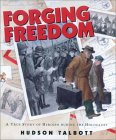 Forging Freedom : A True Story of Heroism During the Holocaust |
Talbott tells the story of his friend Jaap Penraat, who, as a young architectural student in
Amsterdam under the Nazi occupation, saved hundreds of Jews from arrest, first by
forging their ID cards, and then by devising an elaborate escape plan to smuggle them
over the border to freedom. Some of the telling is awkward, with fictionalized dialogue
in a contemporary idiom ("I just don't get it"), and an overt heavy message connecting
the schoolyard bully with Nazi brutality ("Bullies--I guess you never get away from them,
not even as a grown-up"). But the details of the dangerous rescue mission are clearly
authentic, and the reproductions of the forged documents show the trickery. The long
text and narrative pictures give a strong sense of the history of the Nazis' rise to power
and invasion of Amsterdam: one graphic picture shows barbed wire spreading from
Hitler all over the map of Europe. Always present is the horror of what the refugees
are escaping, as well as the exciting action and the heroism of the young man who led
them to safety. Connect this with the Danish rescue books by Deedy and Levine, reviewed
in this section, and also with Ken Mochizuki's
Passage
to Freedom, about Chiune
Sugihara, the Japanese consul in Lithuania, who helped hundreds of Jews to escape by
issuing them visas.
|
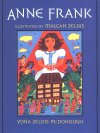 Anne Frank By Yona Zeldis McDonough |
This picture book opens with the Franks fleeing to the annex. Then the author tells about
happier times, the coming of the soldiers, and the beginning of the persecution. Sophisticated
language, topic, and the many flashbacks preclude the book's use with young children. The
explanation of Hitler's accession to power is simplistic; McDonough attributes it solely to
bad economic conditions. Once the author is into Anne's story, however, she tells it in a
straightforward manner and relates it well. The book is illustrated with bright, folk-art
paintings. At first, the pure colors of yellow, red, orange, green, blue, black, and brown
surrounded by alternating borders of the same colors seem inappropriate for such a subject,
but the childlike images provide impetus for discussion, and the bright colors of the innocent
contrast well with the dark colors of the evildoers. The paintings of happier past times are
cozy and cheerful. Mama and baby Anne look like a 1930s version of the Madonna and
child. A small painting of barbed wire encircling crossed Nazi flags on the opposite page
foreshadows the trouble to come. McDonough tells the story, but there's no doubt that
Zeldis provides the emotion. In the final picture, Anne is seen towering over the world and
all its people. She has risen phoenixlike from her diary and has become a myth, a myth that
symbolizes the yearnings of a people to be brave, to be optimistic, and most of all to survive.
Anne did not survive, but her story lives on.
|
 Never to Forget : The Jews of the Holocaust |
By the time World War II was over, the dead included six million
Jews--killed specifically because they were Jewish. This collection of
first-person accounts of the Holocaust serves as a timeless reminder of
how Europe's Jews reacted to the threat of extermination, exphasizing
the wide variety of resistance efforts. Illustrated with photographs.
Description from Publisher Winner of Sydney Taylor Award (Association of Jewish Libraries) |
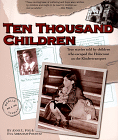 Ten Thousand Children : True Stories Told by Children Who Escaped the Holocaust on the Kindertransport by Anne L. Fox and Eva Abraham-Podietz |
The Kindertransport was a rescue operation that saved 10,000 Jewish children
from Nazi-occupied Europe between December 1938 and September 1939
and found homes for them in England. Only 1,000 of them ever saw their families
again. Olga Levy Drucker's
Kindertransport
is one survivor's detailed
story. The authors of this book were also Kinder who got away to England, and
they have written a profoundly moving, accessible account that combines the history
of the time with the first-person testimonies of 21 survivors. Each chapter begins
with the big picture--life under Hitler, Kristallnacht, preparing to leave, the journey,
life in England through the war years and afterward--and then includes brief vignettes
by Kinder who remember how it was for them; finally, a brief note
summarizes what happened to each child afterward. The design is like an open
scrapbook, with different size typefaces, snapshots, news photos, and marginal notes;
and the combination of the general overview with personal memories will bring readers,
from middle grades through adult, close to the experience. These people escaped; the
brutality is offstage, but the anguish is in the childhood details. What was it like to say
good-bye to your parents, knowing you might never see them again? To arrive in a new
country, learn a new language, and live with strangers? To discover after the war that
your family was gone? Or to find your parents, leave your foster home, and try to be
a family again? The authors' quiet final note is rooted in the survivors' stories: the
Kinder have learned, among other things, to appreciate people's differences
and to remember the kindness of strangers.
|
 Kindertransport by Olga Levy Drucker |
The author of this personal narrative was born in Germany in 1927 and soon found her life
disrupted by the events in Europe in the 1930s. Her mother arranged for her to be part of
the Kindertransport , through which 10,000 Jewish children were sent to live with English
families. Ollie, 11 when she leaves, speaks virtually no English and finds herself in a series
of undesirable living situations: a dingy, louse-infested flat; a luxurious home in which she is
virtually ignored; a boarding school that closes when the war begins; a Baptist family intent
on avoiding sin; and a home with a sickly woman whose illnesses cause Ollie to miss school. At
the age of 16 she leaves her studies to help take care of a family with five children. During
this time Ollie worries about her parents' safety in Germany as the war rages, and keeps
herself going with thoughts of a reunion with them. Eventually, they make their way to New
York, and in 1945, she is able to join them. Her afterword reflects on her experiences as a
refugee. The book is touching as well as exciting, and is one of the World War II
reminiscences that middle school readers will devour.
|
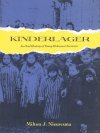 Kinderlager: An Oral History of Young Holocaust Survivors By Milton J. Nieuwsma |
At the Auschwitz-Birkenau concentration camp, the Nazis created a special section for children called the Kinderlager. Three young acquaintances from the town of Tomaszw Mazowiecki ended up together in the Kinderlager and managed to struggle through and survive that terrible place.
Using their own words, Tova Friedman, Frieda Tenenbaum, and Rachel Hyams document their story in Kinderlager, describing their lives before the war, their arrival at the camp, their liberation by the Soviet Army in January 1945, and the lives they rebuilt after the war. It is a story filled with horror and unspeakable tragedy - but also one of remarkable courage and hope. Three Jewish American women from the same town in Poland describe what happened to them as children in the Holocaust. All three ended up in the Kinderlager, the children's section of the Auschwitz death camp. Nieuwsma draws on his in-depth interviews with them and lets each survivor tell it in her own voice. The organization is tight, in three separate sections, with none of the repetition and rambling of loose oral history, but the editorial presence is unobtrusive; each story reads like a memoir. Despite the title and the slightly large-size pages, this is not a book for children. The survivors speak with restraint, there is no sensationalism, but they witnessed atrocity, and they cannot forget it. They survived roundups, transports, selections, and massacre; they breathed the smoke of the chimneys, and they saw the child victims of Mengele's medical experiments "covered with bandages and curled up in pain." After their liberation, they returned to continuing anti-Semitism, even pogroms, in Poland. All three speak of the burden of their mothers' memories as well as their own. Their accounts combine the immediacy of the child's experience with the sophistication of adult hindsight. The occasional haunting family photographs document all that is lost, but contemporary photos show each survivor with her children and grandchildren. Like Anita Lobel in No Pretty Pictures, these women refuse to play celebrity or victim. This book purports neither to examine why the Holocaust happened nor to present a consequential account of how it happened. Its aim is simply to relate what happened, to three young girls from one small town in Poland. Nieuwsma recognizes that for the Holocaust to be at all comprehensible it must be approached on the small scale, through the details-family photographs are included-and in the voices of those who experienced it. The author appears only in the prologue and epilogue framing the three stories, and there is no embellishment of the oral testimony to distance the reader from the events recounted. Indeed, the lucid narrative style is that of memory itself: the three "books" seem like collections of snapshots. In uncomplicated language Tova, Frieda, and Rachel create clear and chilling images evoking childhoods marred by life under the Nazis, moves to cramped shared apartments in ghettos, deportations to labor and concentration camps, and difficult adjustments to freedom. Readers learn not only of the horrors these children witnessed and suffered, but also of the nightmares and depressions the adult survivors endure. The stories are well and simply told; however, Kinderlager is not suitable for younger readers. |
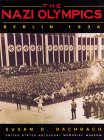 The Nazi Olympics : Berlin 1936 by Susan D. Bachrach |
This book is based on a special exhibition developed by the United States Holocaust
Memorial Museum that is currently touring the country. It offers not only a history of
the notorious Berlin games of 1936, but it also includes the stories of many of the athletes
who took part and those who did not for political reasons. Bachrach delves into the
workings of the Nazi propaganda machine, the controversy inside the U.S. Olympic
Committee as to whether our nation should participate in the games, and the fate of the
Jewish athletes who competed. The athletic feats of Jesse Owens and other African
Americans are well covered. Illustrations include period black-and-white photographs,
cartoons, and posters. The full-color posters at the end of the book do an especially
good job of conveying the Nazis' attitudes toward race and their beliefs in the superiority
of "Aryan Blood," as well as the techniques of propaganda. An annotated time line of the
history of Nazi Germany, suggestions for further reading (mostly adult titles), and a detailed
index are appended. A deeper look at the history and the complexities surrounding this
notorious Olympics than is found in other books.
...should be in every school library...What makes this book a very useful teaching tool for social studies and history classes is its keen account of the complex politics that infused the Olympics...''The Nazi Olympics'' is illustrated with a rich collection of rare visual material, including a selection of full-color Nazi posters promoting the Games, and a few foreign ones protesting them... As children enjoy the 2000 Olympics, and perhaps learn from the team and individual accomplishments, ''The Nazi Olympics'' offers a chance to address the power of sports as a means to capture the public's hearts and minds. The story most often told about the 1936 Olympics is that of Jesse Owens' triumphant performance, which served as a slap in the face to Hitler and his theory of Aryan supremacy. Bachrach looks deeper than this feel-good interpretation to trace the troubled path of the games both in the U.S. and Germany, examining the escalating oppression of Jews, the building of the concentration camps, and U.S. efforts to start a boycott. Bachrach ties those threads together into a comprehensive narrative that provides the right amount of political background to tell the complete story of the games and their athletes--those who competed, those banned from competition, those later murdered in concentration camps, and those who took part in the boycott. Enriched with biographical sidebars and illustrated with photographs from the U.S. Holocaust Memorial Museum, this is a welcome addition to any sports or World War II collection. Chronology; further readings. |
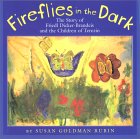 Fireflies in the Dark : The Story of Freidl Dicker-Brandeis and the Children of Terezin By Susan Goldman Rubin |
A profoundly moving testimonial to the resilience of the human spirit
under intolerable conditions. Sent to the Terezin concentration camp
(perhaps more widely known under its German name, Theresienstadt), art
teacher Dicker-Brandeis packed art supplies in her luggage rather than
personal items. Here, in a poignant narrative, is a record of her
wonderful influence over hundreds of doomed youngsters, terrified by the
separation from their families. Her teaching ability and artistic talents
were instrumental in providing an island of sanity in a horrific situation,
and in giving an outlet to the children's emotions. Lavishly illustrated
with artworks by the Terezin children (preserved in two suitcases in a
barracks attic), the book is a chronicle of light in the blackest of hours,
and of a despicable period in human history. A list of references-books,
videocassettes, recordings, and Web sites (many readily usable by young
people)-is included. Elegant in appearance, devastating in content, almost
overwhelming in its quiet intensity, this bookis a shining augmentation to
the literature of the Holocaust.
"Of the 15,000 children who passed through Terezin, only 100 survived. But their artwork and writings live on as testimony to their lives and spirits." This heartbreaking picture book tells the children's story by focusing on their remarkable art teacher, Friedl Dicker-Brandeis, a Jewish artist from Czechoslovakia, who took art supplies and books with her to the concentration camp and ran secret classes for the children. She and nearly all her pupils perished at Auschwitz, but after the war, 5,000 of the children's drawings, paintings, and collages were discovered hidden in two suitcases. The pictures are now exhibited around the world, and many of them are beautifully reproduced on the pages of this book. Some of the work is naive in style; some is sophisticated. There are portraits, self-portraits, and pictures that show horrific camp conditions and dreams of home (for example, a family Passover supper). The facts, including the dates, in the brief captions make you return to the pictures ("Robert Bondy painted empty landscapes over and over again with his village in the distance"). Rubin interviewed several survivors, and she integrates their personal testimonies with the history of the camp. This is an excellent book to use across the curriculum in Holocaust studies, in art, history, and literature classes with middle-grade and older readers. Rubin's detailed references and sources include books, documentary films and videos, and Web sites to help students who want to know more. There's no sensationalism here. Everything is distanced, but the sense of loss is overwhelming. |
 A Special Fate : Chiuneory Sugihara : Hero of the Holocaust by Alison Leslie Gold |
A moving account of an unlikely hero. Sugihara single-handedly saved thousands of
Jewish lives during the Holocaust. With the support of his wife, he issued exit visas while
stationed as a Japanese diplomat in Lithuania. Risking his own life and those of his family
members, he responded to the call to help fellow human beings. Ignoring the orders of
the Japanese foreign ministry, he handwrote thousands of documents so that Jews could
flee Lithuania to travel through Russia to get to Japan and freedom. Sugihara was
eventually transferred out of Eastern Europe but not before he and his own family
experienced the internment camps of Russia. Eventually, he was fired from the foreign
service for his bravery and had to find work elsewhere. At the end of his life, he wondered
if his act of compassion had any impact. He was rewarded by learning that many of the
survivors had been searching for him to thank him for his gift of freedom. Although
Sugihara passed away in 1986, Gold was able to interview his widow as well as two
people who were saved by his act. Thus, the many details of the book are authentic.
The narrative alternates between Sugihara's story and those of the two survivors, rendering
the sacrifices and suffering of each person all the more poignant. This thought-provoking title
joins the growing number of fine Holocaust titles for young people.
|
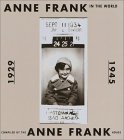 Anne Frank in the World Compiled By The Anne Frank House |
In the spring of 1945, 15-year-old Anne Frank died in the Bergen-Belsen
concentration camp. In 1947, Otto Frank published his daughterís diary.
To date, The
Diary of a Young Girl has appeared in more than 50 different
editions and has sold more than 20 million copies.
This photo essay is an invaluable resource for readers of Anneís diary. It offers a portrait of the Frank family, including many never-before-published photographs. And it also provides an account of the events between 1929 and 1945 that forced the Franks into hiding and resulted in their discovery and imprisonment in concentration camps. With more than 250 photographs, this book helps readers to see what Anne saw and brings the turbulent events that shaped her world into sharper focus. |
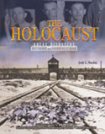 Great Disasters: Reforms and Ramifications The Holocaust By Judy Hasday |
It took a world war to bring an end to the genocide practiced by the Nazis against Jews and other groups in Adolf Hitlerís pursuit of a so-called perfect race. Learn more about one of the worst tragedies man has ever inflicted upon itself.
|
 The Warsaw Ghetto Uprising By Elaine Landau |
In the spring of 1943, thousands of Jews forced to live in the Warsaw ghetto rose up against their Nazi persecutors. This moving history recounts the struggle of these people to survive and hold their community together while living under the constant threat of death.
As the title suggests, this war story recounts the horrors of the battles between Nazis and young Jews in the spring of 1943 in Warsaw, Poland. For several years, young rebel leaders and their followers gathered what meager arms and supplies they could in preparation for the Nazi onslaught. These courageous young people built underground tunnels and bunkers as well as a network of paths through factories and buildings to give them the advantage of quick movement and surprise. Landau captures the rebels' spirit of outrage and hope as well as their despair. In April of 1943, Nazi leaders decided to destroy the ghetto and its occupants as a birthday gift for Hitler. The SS expected to find meek, starving people, but instead met an organized band of fighters with a will to live. Landau tells how the Jewish strength and daring confounded and frustrated the Nazis and turned the rebellion into a month-long battle of lives and wills. The book includes telling period photographs, source notes, and a list of books for further reading. |
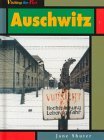 Auschwitz By Jane Shuter |
Visiting the Past is a unique new series that takes students on a guided tour of key places that define human history. Readers gain understanding of the past and how it affects the present by examining each site as it appears today as well as how it would have appeared at its peak. These books overflow with numerous photographs, detailed site maps and diagrams, beautifully rendered reconstruction artwork, and comprehensive text - all of which combine to breathe life into a place, a people, and an era.
The format of this book is deceiving. It is not for very young children, but it looks almost like a picture book. In its 32 pages, though, it covers all the horror that the words "concentration camps," "final solution," or "transport" convey. Shuter manages to talk about the Nazi period of German history in a straightforward tone that isn't sensationalist, but doesn't hide behind platitudes about "just following orders." Each chapter is only a double-page spread (with a lot of photographs), but a lot of information is covered in those two pages. A timeline, glossary, list of more books to read, and an index add to the usefulness of the book. Possibly for reluctant readers. |